Works consulted
To try to find out how codes worked in other Colonies, I
consulted the following:
Postmarks of New South Wales, by R. Tobin (Richard C.
Peck, 1983), pp. 22-32.
South Australia: The Squared Circle Cancellations, by Donald
G. Cox (Hawthorn Press, 1975), Introduction and main tabulation.
Tasmania: The Postal History and Postal Markings, Part II,
by John Avery, P. B. Edwards, O. G. Ingles and J. R. W. Purves (The Royal Philatelic
Society of Victoria, 1975), Chapter VI.
The Cancellations of Melbourne, 1861-1912, by D. G. Davies
and G. R. Linfield in collaboration with J. R. W. Purves (The Royal Philatelic
Society, London, 1980), Section 1.
Code Letters used by Victorian Post Offices, by G. T. White
(Philately from Australia, June 1981, pp. 39-41).
Postage Stamps and Postal History of Western Australia, by
Mogens Juhl, Vol. III (Mogens Juhl, 1983), Chapters 20 and 30.
Victoria
The amount of information on codes varies in these references,
and in some cases, I am afraid, the information given is misleading. However,
the most informative and authoritative is the Davies and Linfield work on
Melbourne, as they cite archival evidence to back up their conclusions. In this
work the authors deal only with the marks applied as cancellations on mail
originating in Melbourne, which consisted of duplex cancellations from 1861 to
1895, and circular date-stamps from 1895 to 1912; they do not deal with the
date-stamps used as back-stamps on arrival or transit mail in the first period,
except a few which were later used as cancelling stamps. As a matter of fact
these too were coded.
The cancelling stamps used at Melbourne (both duplex and
single) incorporated both numbers and letters, the numbers being fixed, and the
letters moveable (memorandum of 19/7/66). That the letters represented a time
code is without any doubt, owing to the archival evidence. There had been a
six-letter system in use from the beginning of 1854, but this was replaced by a
twelve-letter system in July, 1861, when the duplex was introduced; three other
letters were added later. No archival information has been found to explain the
meaning of the numbers found in conjunction with the letters, but the authors
suggest that they probably indicated the particular shift or rota to which the
handstamp was assigned in the sorting office; up to 1895 25 different numbers
had been used, but no more than 22 were in use at any one time.
According to Geoff White's article in Philately from Australia,
Ballarat, Bendigo and Geelong, as well as some other post offices, used the
same letter code as Melbourne, or one very similar, while other offices used a
more simplified system. In fact, in some cases the use of the letter code, and
the numbers, seems to have been very erratic and spasmodic. This article deals
only with the duplex cancellers used as departure stamps.
New South Wales
The use of codes in New South Wales was apparently not
nearly so extensive as in Victoria. Duplex cancellers were introduced at the
Sydney G.P.O. as early as 1857, and these incorporated code symbols, but there
is not very much archival information about them, as they were evidently
ordered privately as required by the Postmaster-General. They were not subject
to public tender as were the obliterators and date-stamps required for other
post offices. Duplex cancellers were not introduced in other post offices until
1877 at the earliest, and they are specifically mentioned in the Tender
documents when these were called for in the Gazette of 7 June, 1878, in which,
inter alia, 10 Hardened Steel Date Stamps (double), with Obliterator attached,
were called for. In these first country and suburban duplexes provision was
made for the insertion of a code symbol, and some of the post offices to which
they were allotted did make use of the facility. Both letters and numbers were
used, but not together as in Victoria a post office that used letters did not
use numbers, and vice versa. In each case the codes were very simple, as only
the letters A, B and C, and numbers 1 to 4 are known. Mr. Tobin says that it is
fairly. certain that these were used to indicate a particular mail despatch
each day. Some larger offices used up to No. 8 in a letter type of duplex, but in
1884 actual time slugs. began to be introduced into the duplexes. A few post
offices continued to use letter or figure codes after the other duplex users
were showing the time, but this was not the norm. There is no doubt, therefore,
that in New South Wales both letters and figures were used in codes in some way
connected with time.
South Australia
In South Australia the early date-stamps used at the G.P.O.
in Adelaide, as well as the few duplexes used there, contained codes, both
letters and numbers, but not together. In addition, a few of the early
date-stamps used at some of the busier offices used figure codes. I do not know
how the codes at the G.P.O. worked, but if we can go by the figure code found
in many of the "squared circle" cancellers, the figures in some of
the circular date-stamps that preceded them are most likely connected with
time. Donald Cox refers to the figures found in the "Squared circles"
as time markings. They could well indicate, like those in New South Wales, a
particular mail despatch.
Tasmania
In Tasmania, the first Hobart duplexes were similar to those
of Melbourne, but with "TASMANIA" instead of "VICTORIA" in
the obliterator portion, and undoubtedly were made by the same manufacturer;
like the Melbourne ones, the Hobart duplexes incorporated a combination of
figure and letter, but being a much smaller G.P.O., the figures were confined
to 1, 2 and 3. The authors of Tasmania Part II were aware that the letters in
the Melbourne duplexes represented a time code, but for reasons that they
believed compelling, they concluded that the letters in the Hobart duplexes did
not, but possibly individual postal clerks. At one time I was also of that
opinion, but I now firmly believe that the Hobart letters, like the Melbourne
ones, represented a time code. Is it a coincidence that the letters found in
the Hobart duplexes, A, D, H, K, L, O, S and T are the first eight letters of
the second Melbourne time code? Later duplexes and contemporary date-stamps
also contained a similar letter code, but in the single date-stamps that
replaced the duplexes as departure markings in the early 1900's, another two
letters from the Victorian list, V and Y, were added. Is it again coincidence
that the date-stamps- incorporating these ten letters were replaced by
date-stamps with indications of time of which ten different are known? These
are not actual times, of course, but termini ad quem, so they are in a sense a
sort of code themselves. Anyhow, I think there is enough circumstantial
evidence to support the theory that the letters in the Hobart duplexes and
date-stamps represent a time code. The duplexes and early date-stamps: used at
Launceston and Zeehan, and the early date-stamps used at Strahan, incorporated
the first eight letters used at Hobart; Zeehan later added V, and Strahan
appears to have used V instead of T. The authors of Part II also report a
solitary case of V (inverted) for Launceston, but this could possibly be an A
where the cross-bar did not register. They still opt for the letters being
allotted to individual clerks, but from what we have learned to date that
possibility seems very unlikely. A further argument against it is that if a
maximum of ten letters was enough for Hobart, it is extremely unlikely that
there would have been eight or nine different clerks on stamping duty at the
three smaller offices, even though we know that Zeehan and Strahan were then
very much busier than they are today. I would say that a time code was involved
in these cases also.
Western Australia
The first duplex used at Perth evidently came from the same
stable as the Melbourne and Hobart ones, incorporating "1 A" in the
date-stamp and "WEST/AUSTRALIA" in the obliterator; it was introduced
in 1870, but the code system evidently did not find favour in Western Australia
at that time, as no other figures or letters are known for this duplex, and it
was withdrawn late in 1873. Mogens Juhl makes a mistake about the codes used in
Victoria, as he says that there the figure stood for the mail and the letter
for the clerk, but as Davies and Linfield have shown, this was not so. Codes
were introduced in 1886 in Perth duplexes, and later in duplexes used at some
other post offices. These were figure codes, but as Mogens Juhl does not
consider these of any philatelic importance, he does not say what the figure
code was at the various post offices concerned. They probably represent mail
despatches, and certainly would have something to do with time, as they were
replaced by others showing explicit expressions of time. If Juhl had realised
this, I wonder if he would have placed more importance on the codes. I suppose
it depends on what one finds interesting, as Mogens goes into rather minute
detail in distinguishing between different implements of the same type used at
the same office.
Having picked other people's brains in relation to codes
used in the other Australian Colonies as far as possible, I now turn what I
have learned to the problem of the codes used in Queensland. It did not take me
long to realise that this was a much more complicated problem, as here we have
both figures and letters, not in conjunction with each other in the same
implement, but separately, and evidently for the same purpose; further, the
letters are found both as capitals and as lower- case italics.
Brisbane
Codes were not used in the first date-stamps and duplex used
at Brisbane, but were evidently introduced about 1865 (my first date is MY 19,
65), and at first capital letters were used in a simple code: A, B, C, D; this
seems to have been used for both departure and arrival or transit stamps. Sometime
in 1867 there appears to have been a radical change, as from then on a number
code was used on departure mail and a lower-case italic letter code on arrival
or transit mail, though occasional exceptions to this rule can be found. The
numbers used in the first type in which they are found ran from I to 10, but it
seems that when they were first introduced, they went up only to 4 or 5, later
extended to 7 or 8, and finally to 10; that the figures were movable, and not
fixed as in the Melbourne duplexes is shown by the fact that "10" is
known both right way up and inverted. Of the lower-case italics, only four
letters are known; a, what is evidently intended as b, c and d; the b is unlike
the italic b used by any of the printers of Philately from Australia, Hawthorn
Press, Advocate Press, or Brown Prior & Anderson, but is more like an
italic v. In at least one type, the d can be found inverted, so appears as p.
The use of lower-case italics appears to have ceased about 1873, after which
the use of roman capitals for arrival or transit mail became the norm. A to D
were used up to 1876, when E, F and H were added; after that, things begin to
get a bit complicated, since from about 1884 to when time slugs began to be introduced
into date-stamps, 22 letters were in use.
The date-stamps in which they are found were mostly intended
for use on arrival or departure mail, but two types, the "Squared
circles" (1883-1891) and the "framed, with asterisks"
(1889-1896) were definitely used on departure mail. The numeral codes used
particularly in the duplexes, are also hard to explain, as from about 1886 the
numbers run from 1 to 36. These facts suggest that the time codes (if, as I
believe, both series were time codes) used at Brisbane were much more extensive
than those used at Melbourne, where no more than 15 letters were ever used.
That there might have been a very sophisticated time-code system in operation
in Brisbane is rather suggested by the fact that, although I have not collected
Brisbane markings as such, I have been able to find, in my own collection and
the illustrations in my book, 22 different time indications amongst the
Brisbane markings that replaced those with letter or numeral codes - it will be
recalled that in the corresponding markings for Hobart, which have been very
much more thoroughly researched, only ten time indications have been found. I
have not been able to discover, however, the inter-relationship between the letter
code, with 22 symbols, and the numeral code, with 36. The problem is not made
any easier by the octagonal date-stamps, in which the numbers incorporated do
not seem to fit into any time scheme. Those with "H" or "T"
have numerals from 1 to 9, but those with "X" run only to 7, and
those with "O" to 5 only; there would seem to be some connection
between the numbers and the volume of mail in each category.
Queensland
The use of codes in Queensland was not confined to Brisbane,
but extended to the larger country offices and some of the suburban ones. In
large offices the usage could cover both duplexes and single date-stamps, and
often to more than one of each. In the following list, which covers only what I
have in my own collection, I merely show the various codes I have, without
detailing the various types in which they are found. In some cases the use of
codes is sporadic, so the same type can be found with or without them. They
are, of course, all types that came into use before time indications were
introduced into date-stamps.
ALBION. Codes A, C, D. BOWEN, Code A.
BUNDABERG, Codes, A, B.
(Duplex). Codes 1, 5, 6, 7, 8, 9, 10, 11, 12, 13.
CAIRNS. Codes B, C.
CHARTERS TOWERS. (Duplex). Codes 1, 11. CHILDERS. Code ZA.
COOKTOWN. Code A, Code 1.
DALBY. Code C.
EMERALD. Code P.
GYMPIE. Codes C, D, E.
INGLEWOOD. Code B.
IPSWICH. Code a. Codes A, B.
MACKAY, Code D.
MARYBOROUGH. Codes A, F, G. Codes 1, 3, 9. (Duplex). Codes
E, H. (Duplex). Codes 1, 3, 4 (inverted), 6, 9, 11.
OAKEY. Code C,
PARLIAMENT HOUSE. Code A
PETRIE TERRACE. Code C. REDHILL Code A.
ROCKHAMPTON. Codes A, B, E, F. Codes a, d (inverted), e, f.
Codes 5, 6. (Duplex). Codes 1, 2, 4, 6, 11.. (Duplex), Code A.
ROMA, Code A.
SANDGATE. Codes D, G.
SOUTH BRISBANE. Code B.
TOOWOOMBA. Codes 1, 2. Codes A, B, C, D, D (inverted). (Duplex).
Codes 1, 6, 7.1
TOWNSVILLE. Codes A, C. Codes 1, 3, 4, 5, 6, 7. (Duplex).
Codes 1, 2, 4, 6, 7, 10, 11, 19, 24.
WARWICK. Codes a, e. Codes B (inverted), D. Codes 6, 9.
WOOLLOONGABBA. Codes C, D, E.
Here, I have just listed what I have, and make no attempt to
elucidate the codes. That they were expressions of time, however, I consider
probable. Possibly it does not matter very much, and maybe Mogens Juhl is right
in considering that the matter is not of any great importance. I myself have no
intention of chasing after every possible variation, but it would be rather
nice to know what the various symbols stood for, in the Brisbane marks
particularly, as we do for the Melbourne duplexes.
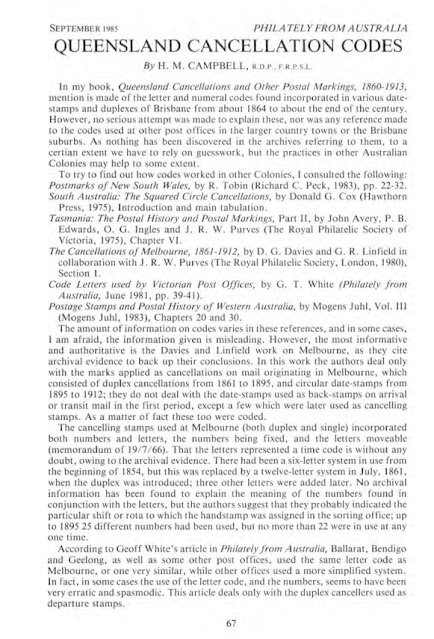
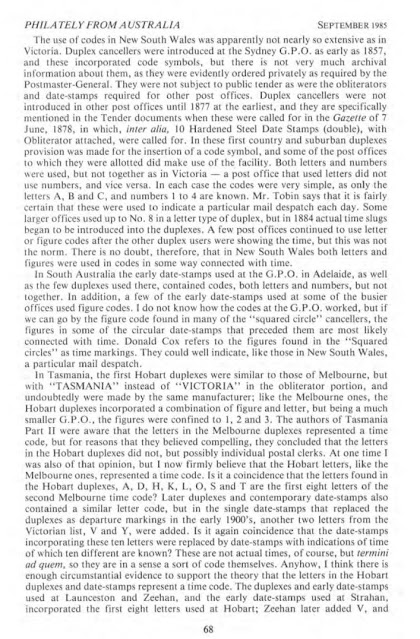
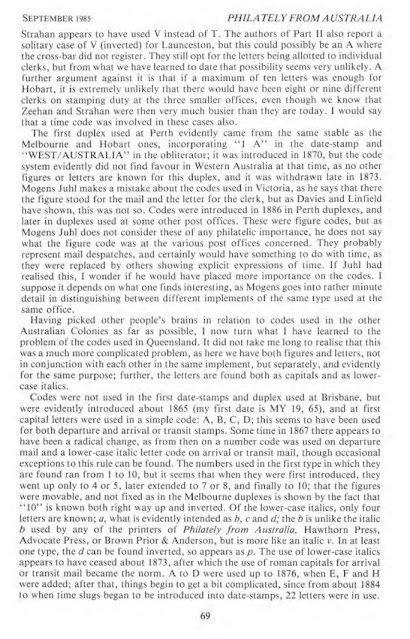
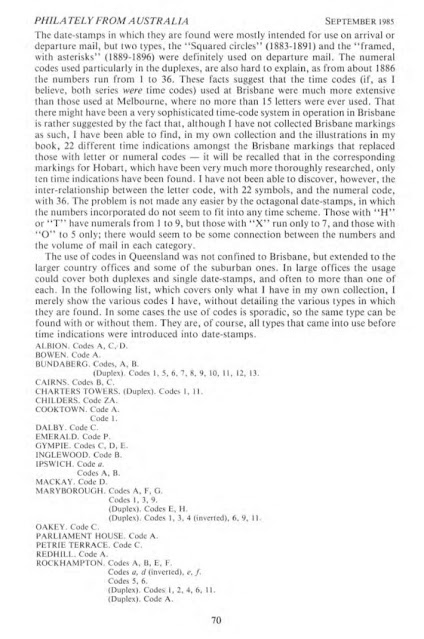
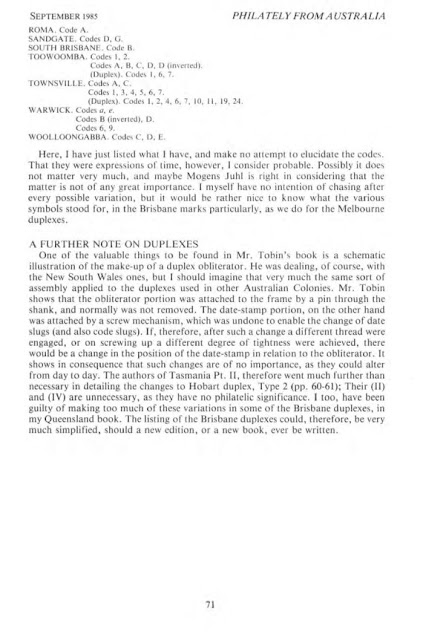

No comments:
Post a Comment